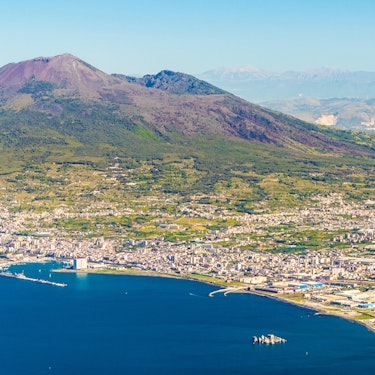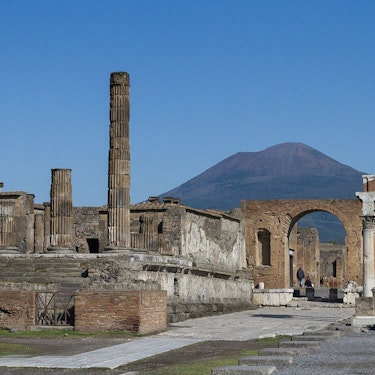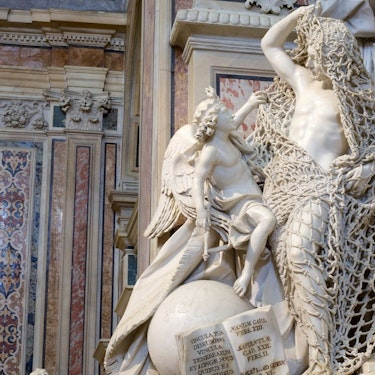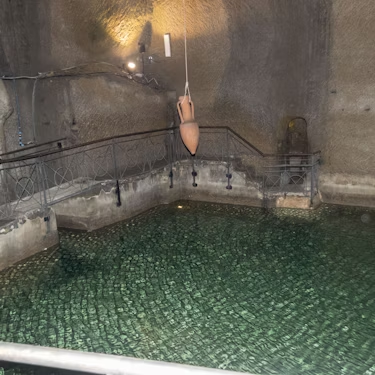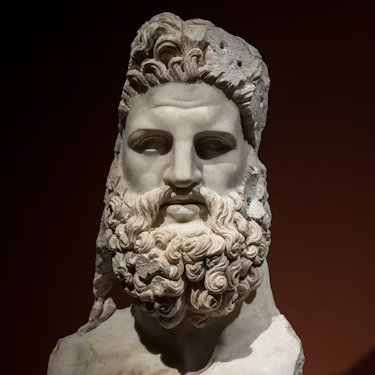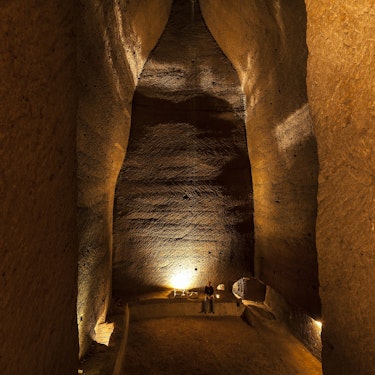More about: Things to Do Near Naples
Are you staying more than three days in the city of Vesuvius? There is plenty to see and do in Naples and its surroundings, as a longer stay is ideal for discovering the region of Campania.
The famous Roman historian Pliny the Elder loved this region and coined the term "Campania illa felix" for its beauty and fertile land. Historic cities, natural masterpieces and gastronomic gems await you in the surroundings of Naples.
1. Set sail for Capri

The famous blue island in the Gulf of Naples has a long history of tourism. Even in ancient Roman times , emperors loved to relax among the Mediterranean scrub and crystal-clear waters. Of the twelve villas of antiquity, only three remain today: Villa Jovis, Palazzo a Mare and Damecuta.
The most interesting to visit is undoubtedly the first one, which was the retirement home of Emperor Tiberius. To visit it on your own, you will need to walk about 45 minutes from the central Piazzetta - Capri's main square - and pay around £5. Visiting hours depend on the season: in winter they are open from 10:00 to 16:00, while in summer they close at 19:00.
The Roman legacy is not the only attraction in Capri. Despite its small size, there are dozens of things to do. The list below reveals the best attractions on the island:
- Saetta, Stella and Scopolo, the three sea stacks. Their name derives from the Greek word 'pharos' (lighthouse), as in ancient times bonfires were lit to signal the presence of the rocks to sailors. To admire them from a privileged position, I recommend booking a table at the Terrazza Brunella restaurant (Via Tragara 24).
- Villa San Michele, a splendid residence built on the remains of a 10th-century chapel. It was built by Axel Munthe, a Swedish doctor who fell in love with Capri. For more information on opening hours and prices, I recommend checking out the official website
- Grotta Azzurra, the island's most famous attraction. It is a natural cavity about 60 metres long and 25 metres wide where the water takes on a magical hue. The entrance is tiny and can therefore only be visited by small rowing boats and if sea conditions permit. Individual visits usually cost around £12.
- Monte Solaro, the highest point on the island. From its summit, you can enjoy a splendid view of Vesuvius and the Gulf of Naples. On clear days, you can also admire the Apennines and the Amalfi Coast and the mountains of Calabria in the distance. A chairlift connects the village of Anacapri with the summit. The price of a return ticket is around £10.
Capri is not a cheap island, as most activities are paid for. A good way to save money is to choose an organised excursion to Capri from Naples. In this case, most expenses are included except for tips and optional activities. These trips usually last around 8 hours.
2. Admire a Baroque gem: the Royal Palace of Caserta

The Royal Palace of Caserta is the largest royal residence in the world. It was built by Charles III of Spain with the intention of rivaling the Palace of Versailles. To achieve this feat, the king commissioned Luigi Vanvitelli, one of the greatest interpreters of the Rococo style, to carry out the work. The palace was completed in 1845 by his son Carlo.
This enormous royal palace covers an area of 47,000 m2 and consists of five floors and four interior courtyards. From the outside, the most striking features are the spectacular fountains inspired by classical mythology. They cover a distance of 3 kilometres and the most famous is probably the Fontana dei Tre Delfini, a fountain with three large dolphins with grotesque features.
There are basically three types of tickets: a single ticket that includes the historic apartments, the park and the English garden (approximately £12) and individual tickets to access the park and the historic apartments (approximately £8 in both cases). Getting there is very easy as it is just a few minutes' walk from Caserta Central Station. For more information, I recommend taking a look at the official website.
3. Spend a day in Pompeii

In 79 AD, Vesuvius buried Pompeii under a layer of ash. The eruption put an end to the history of a prosperous city that exported olive oil and wine and was a holiday resort for the elites of ancient Rome. In the 18th century, after some discoveries were made in nearby Herculaneum, Charles III of Spain decided to finance the excavations.
The survey begun by the king and subsequent surveys brought the buildings of ancient Pompeii back to light. The archaeological site is very large, so it is important to know the attractions you cannot miss:
- The Forum, the economic and religious centre of the city. The ancient shops are still there, along with three temples dedicated to Venus, Jupiter and Apollo.
- House of the Faun, the residence of one of Pompeii's most prominent figures.
- The Lupanare, where carnal desires were satisfied. The brothel was spread over two floors and its walls were decorated with erotic representations. Some of these have survived to this day
- Villa dei Misteri, the home of wealthy Roman patricians. Some historians believe that it belonged to Livia, the wife of Emperor Augustus. It is famous for a large fresco depicting a ritual reserved for devotees of Dionysus
- Orto dei fuggiaschi, the bodies of 13 victims of the eruption. Their escape was cut short at this point and what we can see today are plaster casts of their bodies. This is undoubtedly the most heart-rending spot in Pompeii.
To learn more about the subject, I recommend reading the post that illustrates what to see and do in Pompeii. If you don't have much time to organise your visit, I recommend booking an excursion to Pompeii from Naples. A bus will pick you up at your hotel or at a central point in the city and take you to the archaeological excavations in a comfortable air-conditioned bus.
4. Discover Salerno

About forty minutes by train from Naples is the region's second city: Salerno. In recent years, it has grown considerably from a tourist point of view, and there are plenty of reasons why: it has a long history and is halfway between the Amalfi Coast and Cilento.
To make your trip easier, I have prepared a short itinerary that starts at the train station:
- Lungomare, the promenade that connects the historic centre with Santa Teresa beach. It is completely pedestrianised and adorned with hundreds of trees and plants.
- Cattedrale di Santa Maria degli Angeli, Salerno's main church. Although it looks simple from the outside, once inside it is completely different. The Duomo is located in Piazza Alfano I and can be visited every day from 8:30 a.m. to 8 p.m. (weekdays) and from 8:30 a.m. to 1 p.m. and from 4 p.m. to 8 p.m. (holidays). Entrance to the crypt, where the remains of St. Matthew are preserved, costs €1.
- Giardino della Minerva, a botanical garden created in the 18th century by Matteo Silvatico, a member of the famous Salerno School of Medicine. Here, teachers taught students about the properties and uses of each herb. You can visit it from Tuesday to Sunday, from 9:30 a.m. to 7:30 p.m. A full ticket costs £3.
- Resilienza, a pizzeria that follows the km 0 philosophy. I recommend trying the "Cetarina" (with organic tomatoes, garlic, oregano and anchovies from Cetara) or a "Resilienza" (with parsley pesto, anchovies from Cetara and Fior di Latte, a fresh cheese similar to buffalo mozzarella). In spring and summer, you can eat in the outdoor garden. It is located at Via Santa Teresa 1
- With your stomach full, you can head to Arechi Castle, a medieval fortress overlooking the city and the gulf. Its golden age coincided with the reign of the Lombard duke of the same name, who improved this defensive structure of Byzantine origin. Inside, there is a museum with a collection of weapons, ceramics and coins. Admission is £4.
- Acquedotto Medievale, the aqueduct that carried water to the Monastery of San Benedetto
- Before returning to the station, you can take a detour and return to the seafront. Here you will find Bar Nettuno, an institution for all ice cream lovers. You will find it at Lungomare Trieste 136.
5. Climb Mount Vesuvius after visiting Herculaneum

The archaeological park of Herculaneum is less well known than that of Pompeii, but no less fascinating. There are several differences between the two sites. Firstly, Herculaneum was smaller and overlooked the Mediterranean. Secondly, the eruption had two different effects: while Pompeii was buried under 8 metres of rock and ash, Herculaneum was buried under 25 metres!
The excavations were much more complicated, but archaeologists have nevertheless unearthed a number of finds. The most famous is the Villa dei Papiri, an ancient library that housed Roman manuscripts. Private residences such as the Casa dei Cervi, Casa di Aristide and Casa dell'Albergo are also well preserved.
If you choose an excursion to Herculaneum from Naples, you will have a guide who will reveal the secrets of the place. After about two hours, the bus will take you to the large square at the end of the Ercolano-Vesuvio Provincial Road. Here begins trail number 5, "Il Gran Cono del Vesuvio".
The path runs along the lower edge of the crater and is a natural viewpoint over Mount Somma, the Gulf of Naples and the islands. The first part is probably the most challenging, but don't worry, you don't have to be an athlete to climb it. After this section, it becomes a pleasant walk. The route is circular and takes at least 3 hours to complete.
6. Explore the Valle delle Ferriere nature reserve

Behind Amalfi lies a large green area known as the "Valle delle Ferriere". The name derives from the ironworks that once occupied the area and supplied iron to the Maritime Republic of Amalfi. Hiking enthusiasts will find paradise here; the trail winds through woods, streams and terraces with olive groves, vineyards and citrus orchards.
The starting point is Piazza Flavio Gioia, a stone's throw from the Old Arsenal of the Republic of Amalfi. After passing through the old town, the walk follows the banks of the Canneto stream and enters the mountains until it reaches an old aqueduct. Once there, you can start your return journey.
The excursion is not too strenuous and takes around 3 hours.
7. Admire the Casina Vanvitelliana in Bacoli

A few kilometres from Naples, at the foot of Monte di Procida**, lies a small lake of lacustrine origin**. This is Lake Fusaro, a body of water connected to the sea by two canals. In the middle is a small island that houses the Casina Vanvitelliana, the Gran Restaurant, some pavilions and a park with typical Mediterranean vegetation.
The Real Casino dei Borboni - nicknamed Casina Vanvitelliana - is a late Baroque building designed by the architect Carlo Vanvitelli. The main building is connected to the shore by a scenic wooden bridge. It was used by the kings of Naples for hunting and fishing trips and employed hundreds of people.
It can be visited on Fridays and Saturdays from 5pm to 9pm. On Sundays, the opening hours are divided into two sessions: from 10am to 1pm and from 5pm to 9pm. Tickets cost approximately £5.
In addition to travelling by car, you can reach the lake by public transport. Simply take metro line 2 and get off at Montesanto. From there, take the Cumana train from Napoli-Torregaveta station (a stone's throw from the metro) and get off at the Fusaro stop.
8. Disembark at Procida

Procida is a little gem that is often underrated. Those who visit it fall in love with it, and it would be difficult not to; the pastel-coloured houses and peaceful atmosphere are the perfect antidote to the hustle and bustle of Naples. What's more, the island is surrounded by beaches and small coves with crystal-clear waters.
Every day trip should include a stop at Marina della Corricella, a fishing village famous for its "Vefi", typical arched balconies of Arab origin.
In this area, you will find several restaurants offering dishes based on the freshest fish. I recommend ordering linguini with lobster or pasta alla pescatora povera (with anchovies and fried green chillies).
Ferries and hydrofoils connect Naples with the island of Procida. After a short crossing, the boats dock at the port of Marina Grande, which is just a short walk from the historic centre. A standard ticket costs around £10.
9. Visit the charming Sant'Agata de' Goti

Known as the "pearl of Sannio", it is located about 45 kilometres from Naples. Its origins date back to ancient Roman times and it has retained all its charm.
The old town stands on a tuff rock overlooking two rivers: Martorano and Riello.
It is not the only example of its kind in Italy - Pitigliano is its Tuscan namesake - but it is well worth a visit to enjoy its charm.
One day is enough to enjoy the old town, whose main street is Via Roma. Take the opportunity to admire its many churches and the castle built by the Lombards.
If you want to try the local food, I recommend the Antico Pozzo degli Ulivi. You'll eat among vineyards and olive trees (Via Piana del Mondo)
Sant'Agata de' Goti is also known for its apples, black truffles and wine production. If you have room in your suitcase, take home a bottle of Falanghina. To get here, you will need to hire a car in Naples. The journey takes about an hour.
10. Don't miss Pozzuoli

Pozzuoli reached its golden age in Roman times, as evidenced by monuments such as the Flavian Amphitheatre and the Temple of Serapis. In reality, the latter was not a place of worship but a market adorned with columns and a statue dedicated to the Egyptian deity. On some days, the ground is dry, while on others, the sea floods the ground and soaks its mosaics.
This phenomenon is not regulated by the tides but by bradyseism, a phenomenon very common in the Vesuvian area. In short, the ground rises or sinks depending on magmatic movements. This wonder can be best appreciated in the Solfatara, depressions in the ground from which water vapour mixed with carbon dioxide and hydrogen sulphide escapes.
Getting to Pozzuoli from Naples is very easy; you can take the train (from Napoli Piazza Garibaldi) or the metro (line 2). In both cases, you should get off at the Pozzuoli Solfatara stop. The journey takes about 45 minutes.
Is it worth visiting the outskirts of Naples if I'm only staying for a weekend?

In my opinion, I don't think it's worth it. It's a city with a long history and a growing tourist destination. In addition to the classic monuments and museums, it has unique attractions such as underground Naples, two underground itineraries that reveal a city beneath the city. There are thousands of cultural, historical and gastronomic activities that are worth discovering.
However, if you're visiting Naples in summer and want to get a tan, it's better to leave the city. There are beautiful urban beaches - especially La Gaiola, Scoglione, Lido Sirena and Bagno Elena - but they tend to be very crowded. You'll have better luck on other beaches along the Neapolitan coast or on the nearby Amalfi Coast.





